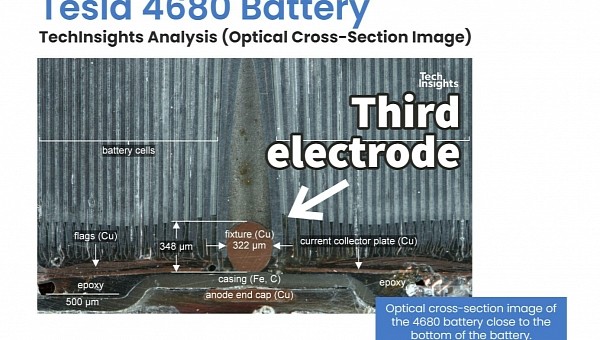Battery experts have noticed that the 4680 cells have three electrical terminals, one more than other round cells used in electric vehicles today. This is puzzling, although some think Tesla might use it to monitor key battery parameters to optimize charging and improve reliability and safety.
Tesla introduced the bigger form factor "4680" battery cells during Battery Day in 2020 and has struggled to manufacture them ever since. The 4680 cells are said to introduce several breakthrough technologies into the market, allowing higher energy density, lower production costs, and better safety. Tesla's 4680 battery cells are supposed to replace the 21700 cells in all battery packs, although this hasn't happened yet. Tesla can only produce them in limited quantities, so most battery cells it uses, including in its structural battery packs, are the 21700 form factor.
The most difficult is to master the dry battery electrode (DBE) process, which is why Tesla acquired Maxwell in 2019. Tesla R&D made strides with the technology and filed several patents over the past months, showing that the new process might get into production soon. Until then, Tesla has taken controversial steps to offer 4680 cells with conventional technology. Previous reports have shown that the 4680 cells are nothing but bigger containers for the regular NMC 811 chemistry used in its 21700 cells.
There's one variation, though, as people discovered that more recent 4680 cells feature three electrical terminals. The discovery was made by TechInsights' battery expert Ali Khazaeli while examining the battery from a 2022 Tesla Model Y. It was confusing at first since no other EV battery cells include a third terminal. Tesla has also kept the new design under wraps, so the expert has tried to reverse engineer the cell to determine the third terminal's purpose. According to Khazaeli, it could be used to measure key parameters of the battery in real time.
Usually, competing products use advanced calculations to make the best guess about the battery's state. Tesla's third terminal, on the other hand, allows it to directly measure these parameters, fundamentally changing how the battery management system (BMS) controls the individual battery cells. This can be used to maximize the charging speed and also increase reliability and safety.
Tesla is just preparing to start production of the Cybertruck, which will feature 4680 cells. Previous reports have indicated that the EV maker has achieved a production milestone for the bigger cells, although this is no guarantee that they can produce them at scale. Tesla Semi was another product that should've featured 4680 cells, but it was launched with 21700 cells instead.
For now, Tesla announced producing 868,000 cells per week, barely enough for 1,000 EVs. The limited production run explains why the Tesla Model Y using these cells is still not listed on the Tesla website. Instead, it is sold in limited quantities directly from inventories. The situation should change as Tesla announced new production facilities for the new cells. The most important is the new battery factory Tesla builds next to Giga Nevada, which will supply the Semi production facility nearby.
The most difficult is to master the dry battery electrode (DBE) process, which is why Tesla acquired Maxwell in 2019. Tesla R&D made strides with the technology and filed several patents over the past months, showing that the new process might get into production soon. Until then, Tesla has taken controversial steps to offer 4680 cells with conventional technology. Previous reports have shown that the 4680 cells are nothing but bigger containers for the regular NMC 811 chemistry used in its 21700 cells.
There's one variation, though, as people discovered that more recent 4680 cells feature three electrical terminals. The discovery was made by TechInsights' battery expert Ali Khazaeli while examining the battery from a 2022 Tesla Model Y. It was confusing at first since no other EV battery cells include a third terminal. Tesla has also kept the new design under wraps, so the expert has tried to reverse engineer the cell to determine the third terminal's purpose. According to Khazaeli, it could be used to measure key parameters of the battery in real time.
Usually, competing products use advanced calculations to make the best guess about the battery's state. Tesla's third terminal, on the other hand, allows it to directly measure these parameters, fundamentally changing how the battery management system (BMS) controls the individual battery cells. This can be used to maximize the charging speed and also increase reliability and safety.
Tesla is just preparing to start production of the Cybertruck, which will feature 4680 cells. Previous reports have indicated that the EV maker has achieved a production milestone for the bigger cells, although this is no guarantee that they can produce them at scale. Tesla Semi was another product that should've featured 4680 cells, but it was launched with 21700 cells instead.
For now, Tesla announced producing 868,000 cells per week, barely enough for 1,000 EVs. The limited production run explains why the Tesla Model Y using these cells is still not listed on the Tesla website. Instead, it is sold in limited quantities directly from inventories. The situation should change as Tesla announced new production facilities for the new cells. The most important is the new battery factory Tesla builds next to Giga Nevada, which will supply the Semi production facility nearby.
Discovery alert! ???? @techinsightsinc found a third terminal in #Tesla’s 4680 #battery, paving the way for improved efficiency, affordability, & #sustainability in #EVs. ?????? Learn more about this game-changing technology. #energyinnovation #cleanenergy https://t.co/83CkAgikLA pic.twitter.com/AyPRLHS29d
— TechInsights (@techinsightsinc) March 22, 2023









